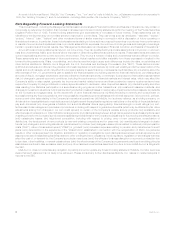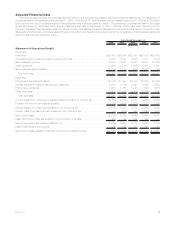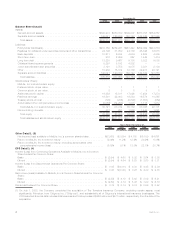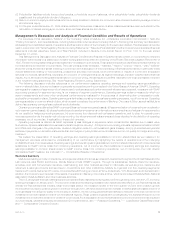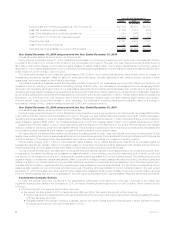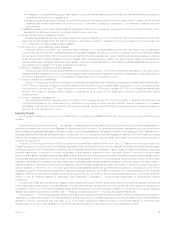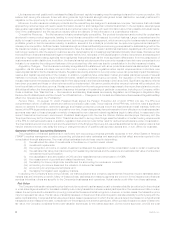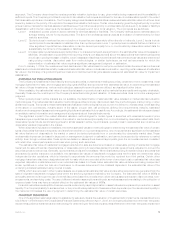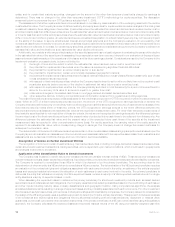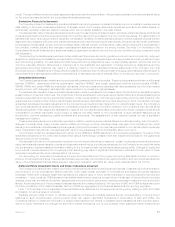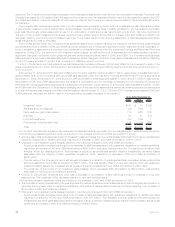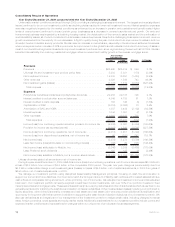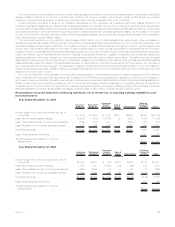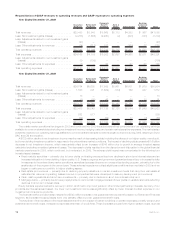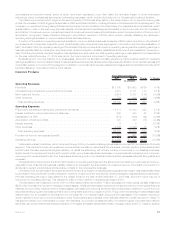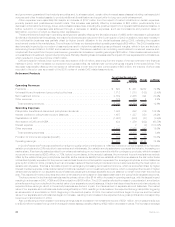MetLife 2009 Annual Report Download - page 16
Download and view the complete annual report
Please find page 16 of the 2009 MetLife annual report below. You can navigate through the pages in the report by either clicking on the pages listed below, or by using the keyword search tool below to find specific information within the annual report.exists, and for certain fixed maturity securities, changes how the amount of the other-than-temporary loss that is charged to earnings is
determined. There was no change in the other-than-temporary impairment (“OTTI”) methodology for equity securities. The discussion
presented below incorporates the new OTTI guidance adopted April 1, 2009.
The assessment of whether impairments have occurred is based on our case-by-case evaluation of the underlying reasons for the decline
in estimated fair value. The Company’s review of its fixed maturity and equity securities for impairments includes an analysis of the total gross
unrealized losses by three categories of securities: (i) securities where the estimated fair value had declined and remained below cost or
amortized cost by less than 20%; (ii) securities where the estimated fair value had declined and remained below cost or amortized cost by 20%
or more for less than six months; and (iii) securities where the estimated fair value had declined and remained below cost or amortized cost by
20% or more for six months or greater. An extended and severe unrealized loss position on a fixed maturity security may not have any impact
on the ability of the issuer to service all scheduled interest and principal payments and the Company’s evaluation of recoverability of all
contractual cash flows or the ability to recover an amount at least equal to its amortized cost based on the present value of the expected future
cash flows to be collected. In contrast, for certain equity securities, greater weight and consideration are given by the Company to a decline in
estimated fair value and the likelihood such estimated fair value decline will recover.
Additionally, we consider a wide range of factors about the security issuer and use our best judgment in evaluating the cause of the decline
in the estimated fair value of the security and in assessing the prospects for near-term recovery. Inherent in our evaluation of the security are
assumptions and estimates about the operations of the issuer and its future earnings potential. Considerations used by the Company in the
impairment evaluation process include, but are not limited to:
(i) the length of time and the extent to which the estimated fair value has been below cost or amortized cost;
(ii) the potential for impairments of securities when the issuer is experiencing significant financial difficulties;
(iii) the potential for impairments in an entire industry sector or sub-sector;
(iv) the potential for impairments in certain economically depressed geographic locations;
(v) the potential for impairments of securities where the issuer, series of issuers or industry has suffered a catastrophic type of loss
or has exhausted natural resources;
(vi) with respect to fixed maturity securities, whether the Company has the intent to sell or will more likely than not be required to sell
a particular security before recovery of the decline in estimated fair value below cost or amortized cost;
(vii) with respect to equity securities, whether the Company’s ability and intent to hold the security for a period of time sufficient to
allow for the recovery of its value to an amount equal to or greater than cost;
(viii) unfavorable changes in forecasted cash flows on mortgage-backed and asset-backed securities; and
(ix) other subjective factors, including concentrations and information obtained from regulators and rating agencies.
The cost of fixed maturity and equity securities is adjusted for the credit loss component of OTTI in the period in which the determination is
made. When an OTTI of a fixed maturity security has occurred, the amount of the OTTI recognized in earnings depends on whether the
Company intends to sell the security or more likely than not will be required to sell the security before recovery of its amortized cost basis. If the
fixed maturity security meets either of these two criteria, the OTTI recognized in earnings is equal to the entire difference between the
security’s amortized cost basis and its estimated fair value at the impairment measurement date. For other-than-temporary impairments of
fixed maturity securities that do not meet either of these two criteria, the net amount recognized in earnings is equal to the difference between
the amortized cost of the fixed maturity security and the present value of projected future cash flows to be collected from this security. Any
difference between the estimated fair value and the present value of the expected future cash flows of the security at the impairment
measurement date is recorded in other comprehensive income (loss). For equity securities, the carrying value of the equity security is
impaired to its estimated fair value, with a corresponding charge to earnings. The Company does not change the revised cost basis for
subsequent recoveries in value.
The determination of the amount of allowances and impairments on other invested asset classes is highly subjective and is based upon the
Company’s periodic evaluation and assessment of known and inherent risks associated with the respective asset class. Such evaluations and
assessmentsarerevisedasconditionschange and new information becomes available.
Recognition of Income on Certain Investment Entities
The recognition of income on certain investments (e.g. loan-backed securities, including mortgage-backed and asset-backed securities,
certain structured investment transactions, trading securities, etc.) is dependent upon market conditions, which could result in prepayments
and changes in amounts to be earned.
Application of the Consolidation Rules to Certain Investments
The Company has invested in certain structured transactions that are variable interest entities (“VIEs”). These structured transactions
include reinsurance trusts, asset-backed securitizations, hybrid securities, joint ventures, limited partnerships and limited liability companies.
The Company is required to consolidate those VIEs for which it is deemed to be the primary beneficiary. The accounting rules for the
determination of when an entity is a VIE and when to consolidate a VIE are complex. The determination of the VIE’s primary beneficiary requires
an evaluation of the contractual rights and obligations associated with each party involved in the entity, an estimate of the entity’s expected
losses and expected residual returns and the allocation of such estimates to each party involved in the entity. The primary beneficiary is
defined as the entity that will absorb a majority of a VIE’s expected losses, receive a majority of a VIE’s expected residual returns if no single
entity absorbs a majority of expected losses, or both.
When assessing the expected losses to determine the primary beneficiary for structured investment products such as asset-backed
securitizations and collateralized debt obligations, the Company uses historical default probabilities based on the credit rating of each issuer
and other inputs including maturity dates, industry classifications and geographic location. Using computational algorithms, the analysis
simulates default scenarios resulting in a range of expected losses and the probability associated with each occurrence. For other investment
structures such as hybrid securities, joint ventures, limited partnerships and limited liability companies, the Company takes into consideration
the design of the VIE and generally uses a qualitative approach to determine if it is the primary beneficiary. This approach includes an analysis
of all contractual and implied rights and obligations held by all parties including profit and loss allocations, repayment or residual value
guarantees, put and call options and other derivative instruments. If the primary beneficiary of a VIE can not be identified using this qualitative
approach, the Company calculates the expected losses and expected residual returns of the VIE using a probability-weighted cash flow
10 MetLife, Inc.




